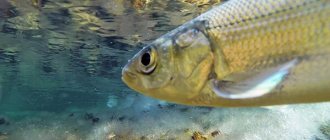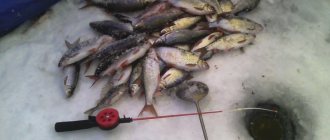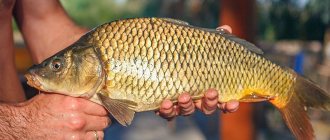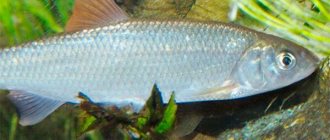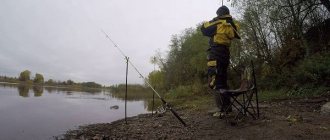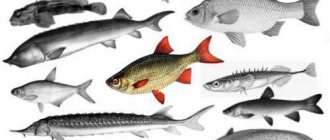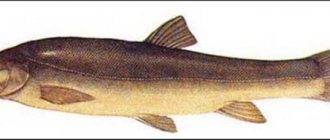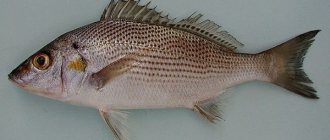Smelt fish: description
Smelt is a small silvery fish. It has an elongated, slender body with a pointed triangular dorsal fin and a strongly forked tail. The back and upper sides of the body range in color from green to dark gray. The lower sides are silvery, sometimes with a pinkish tint. The tail and fins may be translucent.
Smelt
In size, smelt usually grows to about 20 cm in length, although some species can reach 70 cm.
Because these small fish have sharp teeth on their jaws, smelts are considered predators.
Description
The smelt has an elongated body, large, slightly falling scales. Large mouth. The body color is silvery on the sides and brownish-green on the back. The jaws have small, weak teeth.
The lateral line is usually visible up to the fourth - sixteenth scale, but sometimes up to the fourth - eighth scale. When a fish spawns, tubercles form on its body, head, and fins.
The smelt itself smells like a fresh cucumber. This fish has a difference from the similar bleak - an additional fin on the back.
The difference between the European and Asian smelt is that it has weaker teeth and a shorter line on the side. The smallmouth smelt has a small mouth and a large protrusion at the lower jaw.
The shorter dorsal fin has a slightly different location compared to other breeds; like the ventral fin, it is located in the center of the fish’s body.
The length of sea smelt is smaller, the line on the side is limited to nine to thirteen scales.
Where smelt is found and its types.
There are several types of smelt:
- European smelt
- Asian smelt
- Dwarf smelt
- toothy smelt
European smelt
It lives in the coastal waters of Europe from the Baltic Sea to the Bay of Biscay, and in the inland waters of Scandinavia. In Russia, European smelt lives in river basins flowing into the Baltic, White, Barents and North Seas. There is also a small freshwater subspecies of this fish - smelt, which lives in Lakes Ladoga and Onega, in Valdai. Lives up to 3 years. Its length is 9-10 cm, and its weight does not exceed 8-10 g.
Asian smelt
The species includes several subspecies. Lives in the northern seas. It is found in Chukotka, Kamchatka, the Sea of Okhotsk coast, the Kuril Islands, Sakhalin, the Amur, and in the Peter the Great Gulf (Razdolnaya River).
Dwarf smelt
It differs from European smelt in slower growth, earlier maturation, shorter lifespan, and later spawning time. It is found in lakes in eastern Canada and the USA, in the state of New England.
toothy smelt
Found in the White, Bering, Okhotsk, Sea of Japan, and in the Laptev Sea. Also lives in the Pacific Ocean.
Places and habitat features of smelt
Determining the habitat of this species is quite difficult, especially in the summer. At this time, it moves as far as possible from the shore and stays quite deep. So, catching it, despite the fact that smelt is a schooling creature and they stay in huge groups, is quite difficult during hot periods.
It is easier to do this when the river is covered with ice.
However, we should not forget that it is useless to do this in the first days of frost, since at this time all aquatic living organisms freeze, falling into a state of controlled shock. They stop eating, hunting and move little. After the water surface is covered with ice, you can start fishing.
It is worth remembering that this predator chooses the middle layers of water, rarely rising or falling to the bottom, as well as weak currents, since stronger ones put them in a stressful state. But they will stay above the deepest parts of bays or rivers, as well as above the bottom covered with squeak or clay.
Catching this type of predatory fish will require a lot of effort. It is also worth remembering that the flock constantly moves from place to place, and therefore one hole will undoubtedly not be enough.
Where are European smelt found?
Both seas and lakes can become habitats for the European trumpet.
Seas:
- Baltic;
- Northern.
Lakes:
- Ladoga;
- Onega.
Where to find Asian smelt?
- Arctic Ocean;
- White Sea;
- Barencevo sea;
Where are smallmouth smelt found?
- Pacific Ocean;
- Kamchatka.
What does smelt eat?
Smelt feeds mainly on small plankton, crabs, invertebrates, tadpoles, and crustaceans. Large individuals can attack juveniles and adults of other species. Smelt feeds actively, regardless of the time of year, but is especially active in summer and autumn.
The smelt itself is a food source for many fish, including salmon, striped bass and lake trout.
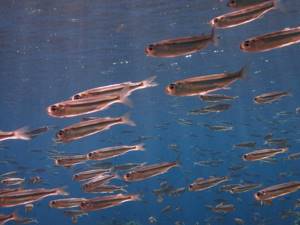
Catching smelt
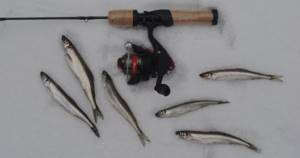
Catching smelt requires a good reaction, since when caught it behaves cheerfully, until the very last moment the fish tries to escape from the hook. It is mobile and active, and in order to catch it, you must act carefully and quickly.
Smelt is insensitive to tackle and does not require thin lines or microhooks. Often, black fishing line with a diameter of 0.3 millimeters is used to catch smelt. Black fishing line is used to better see where the wind blows it, and the advantage of using a thick fishing line over a thin one is that the former is less tangled in the cold and can be pulled without fear of it breaking.
Also, for a successful catch, you need a colorless leash with a diameter of 0.18 millimeters, a light-accumulating jig, a hard nod and a “filly” fishing rod.
The best bait for smelt is considered to be finely chopped fish. But the fish is practically omnivorous, so it can take on worms, shrimp, beef and spinners.
Top 5 baits for smelt:
- small pieces of fish
- shrimps;
- crab sticks;
- bloodworms and maggots;
- red dung worm.
It’s not easy to catch 20–40 fish in one day, because even experienced fishermen catch no more than ten smelts per fishing trip. Also, special knowledge and skills are required to catch smelt in winter.
Catching smelt from the shore - video
Fishing for smelt
You can use the simplest gear for winter fishing, as long as it is comfortable. Many people make them at home. Dense foam goes on the handle - it is made in the shape of a cylinder, with two legs attached for support.

A twisted spring nod is made about eight to ten centimeters long, and a bright piece of foam in the form of a ball is attached at the end.
The fishing line is taken with a diameter of approximately zero point three millimeters. Due to constant friction with ice, it must be constantly updated annually.
If the jig glows, it’s very good. The spindle shape is very popular.
The hook must be well sharpened and suitable for the appropriate dimensions of the intended catch.
Typically, from two to fifteen jigs are used, it all depends on the conditions in which fishing is carried out.
Interesting and effective are shelf fishing rods that immediately cover several layers of water.
For them, of course, more jigs are consumed, which are placed at approximately a meter distance from each other. A standard fishing rod usually has a couple of jigs.
A drop-shaped sinker, weighing about forty-five grams, is attached five centimeters below the lower jig. The upper jig is located about twenty centimeters higher than the lower one, and the third one is a meter narrower from it.
The movement of fish is influenced by currents arising from the tidal activity of the sea. Weather conditions do not have much influence on the effectiveness of biting.
For a successful fishing result, you need to carefully understand the features of the bottom surface and have many years of experience in fishing at specific points.
Why is smelt expensive?
Smelt is expensive because it is a seasonal fish and can only be caught between mid-April and the end of May. So the price depends on the fact that the volume of smelt production is falling every year and the demand in the St. Petersburg market began to be replenished by small Ladoga smelt, as well as European smelt imported from the neighboring Baltic states. It is also worth noting that smelt is a migratory fish. Its main habitat is in the Baltic Sea, and it enters the Gulf of Finland and inflowing rivers for spawning. The fish come in dense schools and appear in the Neva in May.
Where to catch smelt in winter

This small fish prefers to gather in large, numerous schools, the mass of which can reach a ton. Moreover, there may be several such flocks. It is difficult to even imagine what density of fish is in a certain area of the reservoir.
To determine the location of a school of smelt, just look at the surface of a reservoir covered with ice. Where there is the greatest concentration of fishermen, there is a school of fish. At the same time, the density of fishermen is also amazing: there can be thousands of them per square kilometer. Despite this, each of them will be able to catch several kilograms of fish. This suggests that there are several large schools of smelt in the immediate vicinity of fishermen.
Smelt prefers to be in places where small rivers flow into large ones. This is due to the fact that it will go to small rivers to spawn. Therefore, river mouths are its favorite stopping place. While in this place, she prepares to go to spawn.
Sometimes smelt are caught from a depth of about 20 meters; on rivers with shallower depths, they bite at a depth of 4 to 8 meters. This fish prefers places with a flat bottom, unlike other types of fish that go to pits with significant depths for the winter.
It is caught between the bottom and up to 1 meter away from the bottom. The bait is played by raising it to a height of 1 meter and lowering it to the bottom. It is on this horizon that the bites occur. Although there are cases when smelt accumulates at other depths. In this case, a lot depends on weather conditions.
Useful properties of smelt
Smelt is a fish that not only has tasty meat, but is also very healthy for humans.
Skin health
Smelt contains B vitamins necessary for metabolic processes in the body, for skin restoration and growth. Additionally, omega-3 fatty acids may help reduce skin inflammation. Smelt fish is rich in selenium, an antioxidant that improves the appearance of skin and reduces signs of aging.
Improves hair
Regular consumption of smelt fish saturates the body with vitamins and minerals necessary for hair to look healthy. It contains omega-3 fatty acids and natural oils, which are essential for improving the shine or shine of hair by suppressing inflammation in scalp conditions such as dandruff.
Provides energy
Phosphorus is a mineral in the body and is an essential element for converting nutrients into usable energy. One serving of smelt provides 20% of the daily requirement for the mineral. Effectively delivers nutrients and energy to cells.
Strengthens the nervous system
Calcium, an electrolyte, is a key part of signal transmission in the nervous system.
Heart diseases
Fish contains moderate amounts of potassium, which acts as a vasodilator. It helps reduce tension in blood vessels and arteries. This reduces the likelihood of atherosclerosis, strokes, heart attacks and coronary heart disease.
Cholesterol balance
Smelt is high in omega-3 fatty acids, which promotes cholesterol balance and heart health by reducing plaque deposits in the arteries.
Prevention of osteoporosis
Fish contains various minerals such as phosphorus, manganese, copper, calcium, iron and zinc, which are related to bone mineral density in the body. Bone density begins to decline as we age, so consuming fish high in minerals helps reduce the early development of osteoporosis.
Chronic diseases
Fish meat contains large amounts of selenium. Each serving offers 45% of your daily requirement. This mineral acts as a powerful antioxidant. This reduces oxidative stress in the body and reduces the likelihood of chronic diseases such as heart disease, rheumatoid arthritis and cancer.
Promotes development and growth
A serving of smelt provides 30% of your daily protein requirement. The amino acids in proteins can be restored to produce muscle tissue and aid metabolism and support weight loss efforts.
Smelt festivals

The smelt festival has become part of the annual calendar of events in different parts of the world. Gastronomic travel is a current trend in world tourism, so guests from neighboring countries and regions are happy to come to the festival dates.
In Inye, South Korea (Gangwon Province), an annual ice fishing festival is held at Soyang Lake from January 30 to February 2, coinciding with the annual release of smelt into fresh water for spawning.
The village of Lewiston, New York, on the lower Niagara River, celebrates an annual two-day smelt festival the first weekend in May. During the festival, approximately 350 pounds of smelt are baked and fried on the Lewiston waterfront.
Lithuania celebrates the annual smelt festival over the Palanga weekend "Palangos Stinta" in early January.
During the spring smelt run in the Neva, at the head of the Gulf of Finland on the Baltic Sea, a smelt festival (Smelt Festival) is celebrated in St. Petersburg.
Restaurant "Koryushka"
Smelt, although a small fish, is known almost all over the world. She won the hearts of many; not only are festivals held in her honor, but even restaurants are named after her.

Restaurant “Koryushka”, photo KudaGo
The Koryushka restaurant is one of the most luxurious and fashionable establishments in St. Petersburg and amazes with its unique views of the city. These are the open spaces of the Neva, the fortress walls, which allow you to momentarily find yourself in a fantastically beautiful place and forget about the bustle of the city for a couple of hours, enjoying a leisurely lunch or dinner. Over its short history, the establishment has already managed to win the love of loyal fans for unrivaled service and quality recreation.
The restaurant menu is quite varied, so everyone can choose a dish to suit their taste. The restaurant in St. Petersburg “Koryushka” offers visitors a choice of Caucasian, Russian and European cuisines. When you visit a restaurant, you can of course try smelt cooked in breaded bread with nuts and tkemali sauce.
